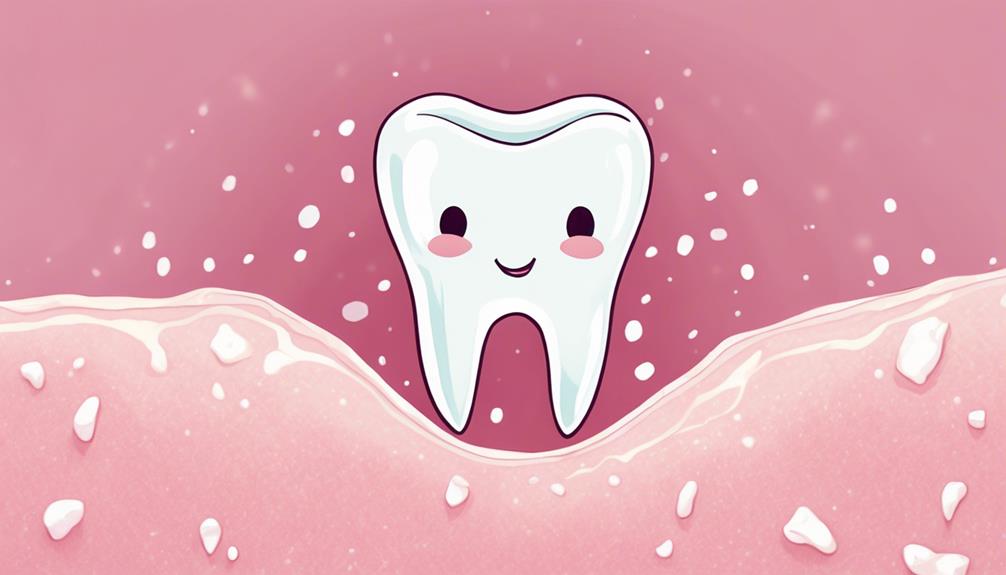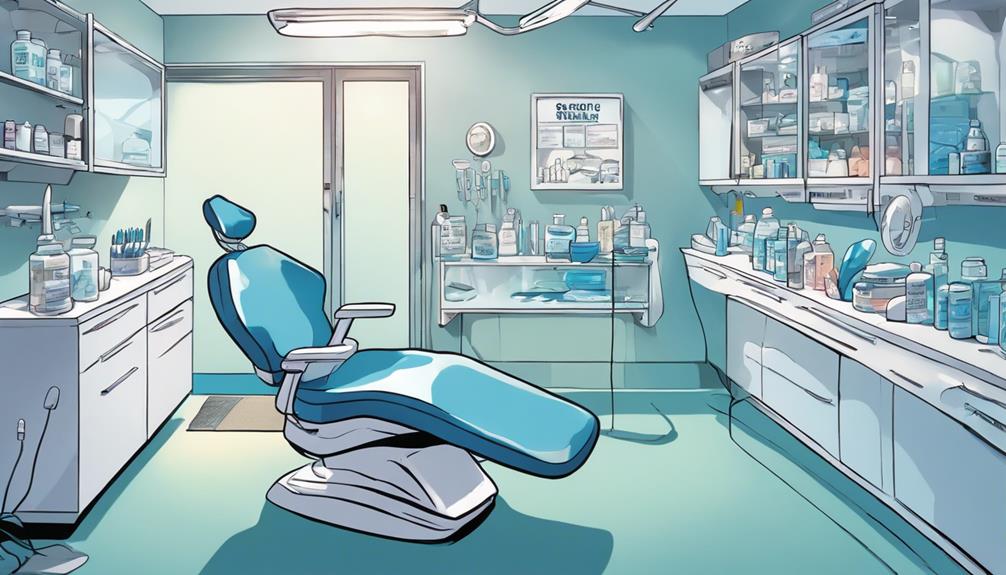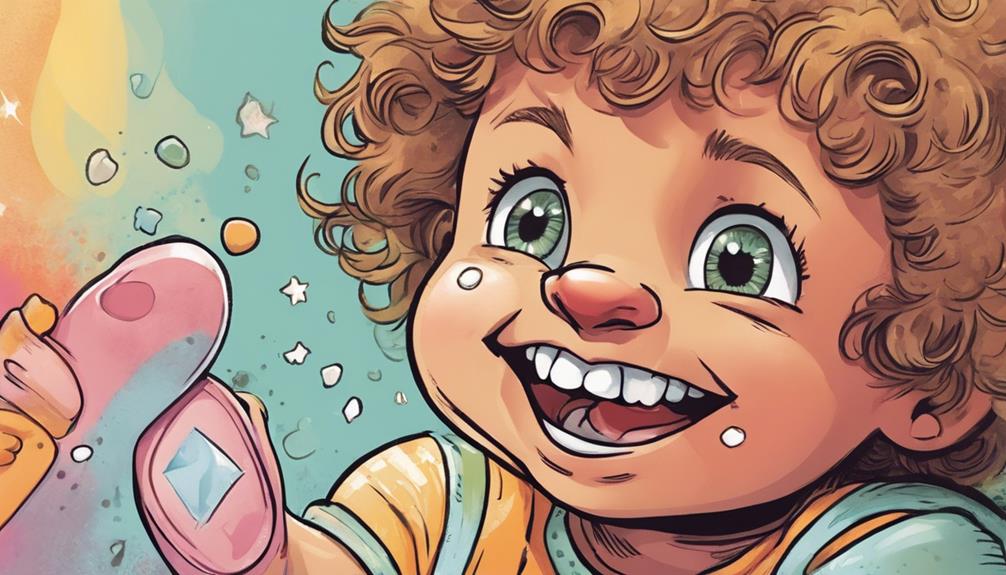Baby teeth have roots that are essential for anchoring them securely in your child's gums. These roots support the teeth, allowing for proper chewing and speech development. Each root connects to the underlying bone through a structure called the periodontal ligament. This anchoring system also guides the eruption of permanent teeth, ensuring they come in correctly. The roots are shorter and narrower than those of permanent teeth, which allows for their natural loss as your child grows. Understanding the significance of these roots is important for maintaining your child's oral health and development. There's plenty more to explore on this topic! Furthermore, the health of your child’s baby teeth roots can also have implications for their overall health. Research has shown that there may be a link between kidney disease and oral health, highlighting the interconnectedness of the body’s systems. Therefore, ensuring that your child’s baby teeth and their roots are properly cared for can have long-term benefits for their well-being. It’s important to stay informed and proactive about your child’s oral health to promote their overall health and wellness.
Key Takeaways
- Baby teeth have roots to securely anchor them in the gums, facilitating chewing and speech functions.
- Roots support the temporary nature of baby teeth, allowing for natural exfoliation as permanent teeth emerge.
- Healthy roots ensure proper alignment of baby teeth, guiding the eruption of permanent teeth.
- Roots contain nerves and blood vessels, enhancing sensory perception and overall tooth function.
Anatomy of Baby Teeth
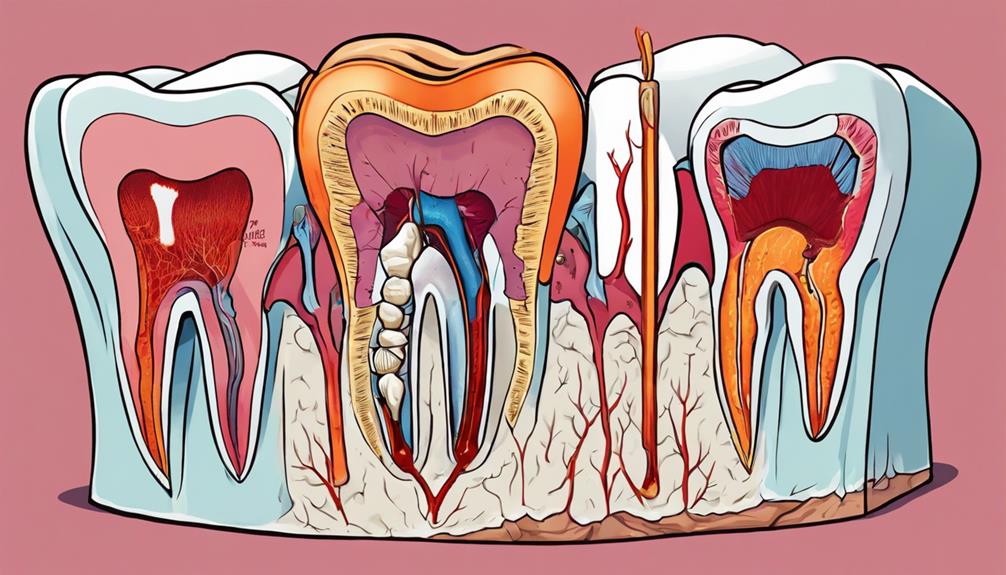
Baby teeth, or primary teeth, have a unique anatomy that plays an important role in your child's oral development. Each baby tooth consists of four main parts: enamel, dentin, pulp, and roots. The roots of baby teeth are shorter and narrower than those of permanent teeth, providing stability while allowing for the eventual loss of these temporary teeth as your child grows.
Typically, each baby tooth has a single root, except for molars, which feature multiple roots to support their larger crowns. This design is essential for your child's oral health, as it guarantees proper function for chewing and speaking. The anatomy of baby teeth is specifically tailored to accommodate the smaller jaws of infants, creating the right spacing for the later eruption of permanent teeth.
Understanding the anatomy of baby teeth helps you appreciate their role in your child's overall dental development. The roots not only anchor the teeth but also influence the alignment and position of adult teeth. Keeping these primary teeth healthy is critical, as it sets the foundation for a lifetime of good oral health and proper dental function.
Importance of Baby Tooth Roots
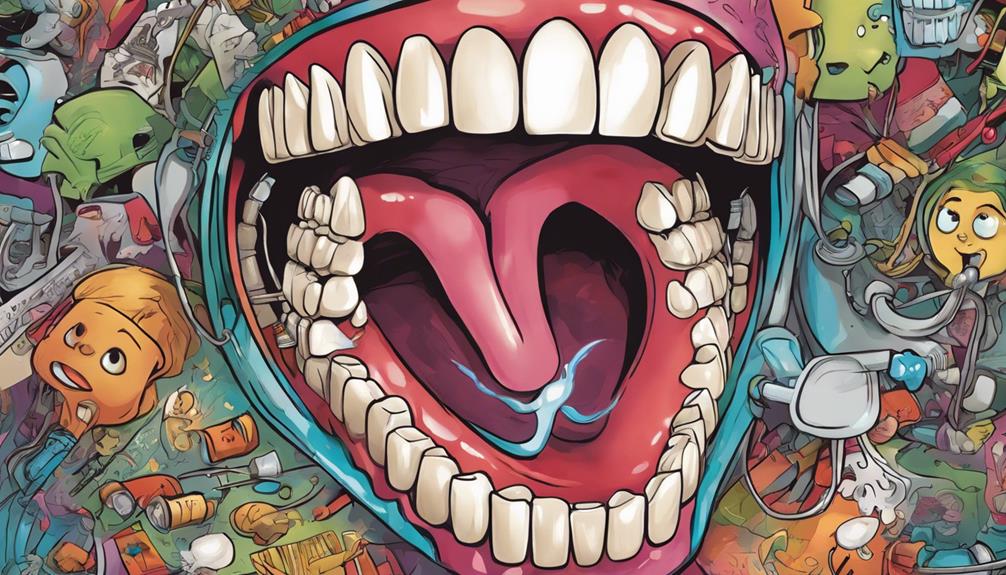
The roots of baby teeth play an important role in anchoring the teeth securely in the gums, which is vital for proper chewing and speaking. These roots provide the stability needed for your child to eat and articulate words clearly. Healthy roots also help maintain the correct alignment of baby teeth, guiding the eruption of permanent teeth. This alignment is essential for your child's oral health as it sets the stage for a straight and healthy smile.
Furthermore, baby tooth roots are shorter and narrower than those of permanent teeth, enabling a natural exfoliation process. As the adult teeth develop, they resorb the roots of baby teeth, allowing them to fall out at the right time. This process prevents premature mobility of baby teeth, guaranteeing they stay in place until it's time for them to be replaced.
Additionally, the roots serve as pathways for nerves and blood vessels, which contribute to the sensory functions and overall health of the teeth. By focusing on dental care that promotes healthy roots, you can help make certain your child's baby teeth serve their purpose effectively until they're ready for the permanent replacements.
Structure of Baby Tooth Roots
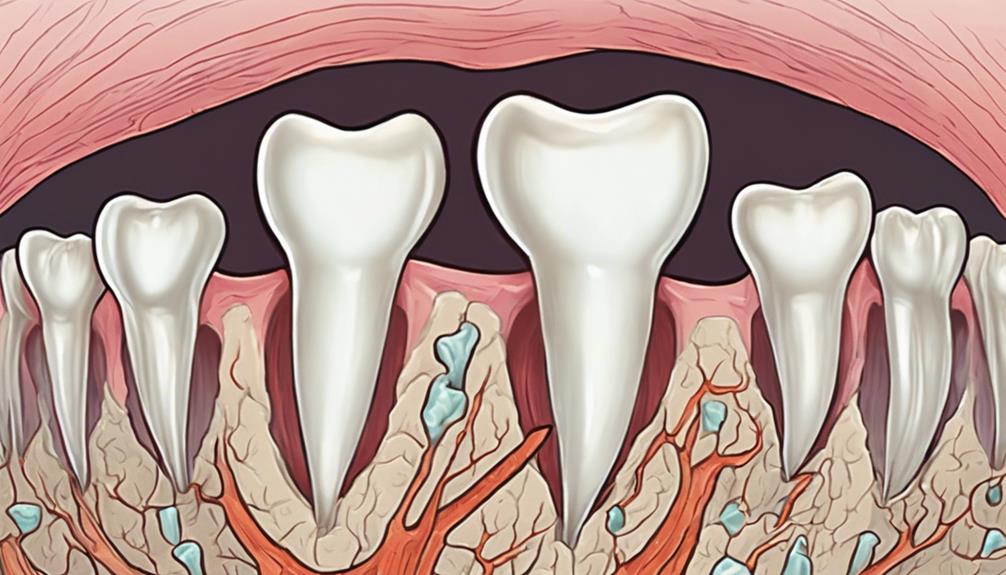
Understanding the structure of baby tooth roots reveals how they provide essential stability and support for your child's growing teeth. Baby teeth roots are shorter and narrower than those of permanent teeth, ensuring a secure fit in the gums. Each primary tooth usually has a single root, while molars feature multiple slender roots that extend beyond the crown. This design accommodates the growth of permanent teeth, allowing for a smooth shift.
The roots of baby teeth are made of cementum, connecting to the alveolar bone through the periodontal ligament. This anchoring system maintains stability while also facilitating resorption, where the roots dissolve as permanent teeth emerge.
Additionally, baby tooth roots play a significant role in sensory perception. They contain nerves and blood vessels that transmit signals related to temperature and pain, helping your child understand the world around them.
For parents, understanding these structures is essential for pediatric dental care. By knowing how baby teeth roots function, you can better appreciate their importance in your child's dental development and overall health.
Impact of Cavities on Roots

Cavities can seriously impact the roots of baby teeth, leading to pain and infection if left untreated.
You mightn't realize that these issues can disrupt the development of your child's permanent teeth as well.
That's why early treatment is essential to protect both the roots and your child's overall dental health.
Cavities Affect Root Structure
Compromising the integrity of baby teeth, untreated cavities can lead to significant root damage and potential infections. When you neglect cavities in baby teeth, the decay can extend beyond the enamel, affecting the root structure. This damage not only threatens the stability of the baby teeth but also impacts the development of the underlying permanent teeth.
If the roots become compromised, it can disrupt their ability to hold onto the baby teeth securely. This lack of retention can lead to premature tooth loss, which may cause misalignment of the permanent teeth. Regular dental check-ups are essential for catching cavities early, allowing for timely intervention that can protect both the baby teeth and their roots.
Maintaining healthy baby teeth is critical for overall oral health. Infections in the roots from untreated cavities can have long-lasting effects, influencing not just the current dental landscape but also the emergence and health of permanent teeth. Prioritizing your child's dental care can help guarantee that their baby teeth serve their purpose, providing a healthy foundation for their adult smile.
Pain and Infection Risk
How do untreated cavities lead to pain and infection in baby teeth?
When cavities form in baby teeth, they can extend deep into the roots, exposing nerves and causing considerable pain. This discomfort can affect your child's ability to eat or focus, making everyday activities challenging.
If left untreated, these cavities can become infected, leading to dental infections that may spread to surrounding tissues, creating more severe complications. Infected roots not only cause immediate pain but can also disrupt the development of permanent teeth.
The inflammation from an infection weakens the roots, increasing the risk of premature tooth loss, which can impact your child's ability to chew and speak properly. Additionally, the presence of untreated cavities can lead to alignment issues for their future teeth, affecting their oral health long-term.
To prevent pain and infection, it's crucial to keep up with regular dental check-ups. These visits help monitor any signs of cavities and guarantee that both primary and permanent teeth remain healthy.
Importance of Early Treatment
Addressing cavities in baby teeth promptly is essential to protecting the roots and ensuring the healthy development of permanent teeth. When you ignore cavities in primary teeth, it can compromise their roots, leading to pain, infection, and even affecting the formation of the underlying permanent teeth. This can result in misalignment or delayed eruption, which can have lasting effects on your child's oral health.
Early treatment is important to prevent these complications. By visiting a pediatric dentist regularly, you can catch cavities before they escalate. The American Academy of Pediatrics highlights the importance of addressing dental issues in baby teeth, emphasizing that the health of these primary teeth directly impacts the development of the adult teeth.
When you prioritize your child's dental visits and seek early intervention for cavities, you help preserve the integrity of their baby teeth and roots. This proactive approach not only alleviates potential pain and infection but also sets the stage for a healthier smile in the future.
Eruption Patterns of Baby Teeth
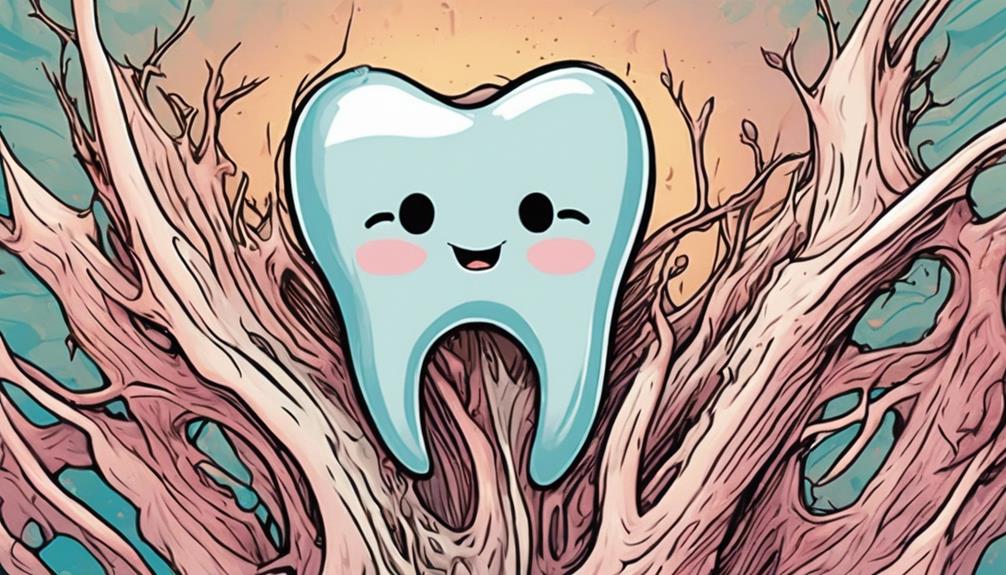
When it comes to baby teeth, understanding their eruption patterns can help you track your child's dental development.
You'll notice that most kids start getting their first teeth around 6 months, with a specific sequence that includes the lower front teeth first.
Keep an eye out for any common eruption issues, as monitoring these patterns is key to ensuring healthy smiles.
Timing of Tooth Eruption
Baby teeth usually start to emerge around 6 months old, with the lower front incisors being the first to make their appearance. By the age of 3, your child typically has a complete set of 20 baby teeth. Understanding the timing of tooth eruption is vital for maintaining your child's oral health and developing good hygiene habits.
Here's a breakdown of the eruption pattern:
| Age (Years) | Eruption Stage |
|---|---|
| 0-3 | Eruption of baby teeth |
| 6-13 | Loss of baby teeth |
| 12+ | Eruption of permanent teeth |
As baby teeth begin to fall out starting around age 6, they pave the way for 32 permanent teeth. The order usually kicks off with the lower front teeth, followed by the upper front teeth, and then the molars. However, keep in mind that individual timing can vary widely. Regular dental check-ups are necessary during this time to guarantee proper tooth eruption and overall dental health. Monitoring your child's oral hygiene habits now can set them up for a lifetime of healthy teeth.
Common Eruption Issues
Eruption issues can arise during the change from baby teeth to permanent teeth, affecting your child's dental health and alignment. Typically, baby teeth erupt in a specific order, with the lower front teeth coming in first. However, variations can occur, and all 20 primary teeth usually appear by age 3.
One common problem is ectopic eruption, where a permanent tooth grows in an incorrect position. This misalignment can impact the loss of the primary tooth, leading to complications down the road. In some cases, retained primary teeth can become an issue; they may not fall out naturally, blocking the way for the permanent teeth underneath and causing further misalignment.
To address these eruption issues, regular check-ups with a pediatric dentist are essential. They can monitor your child's dental development, ensuring that any potential problems are spotted early.
Care for Baby Teeth
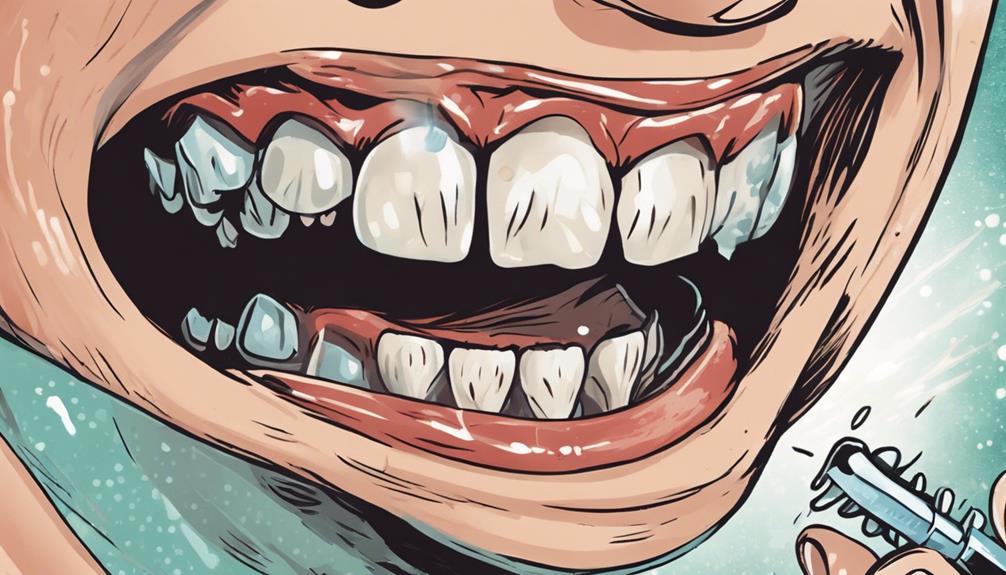
Caring for your child's baby teeth starts as soon as the first ones come in, typically around 6 months old, to help prevent cavities and infections.
Establishing good oral hygiene early on is vital for your child's dental health, as healthy baby teeth pave the way for strong permanent teeth later.
Here are some essential tips for maintaining your child's teeth:
- Use a soft-bristled toothbrush and fluoride toothpaste to brush twice daily.
- Limit sugary foods and drinks, especially before bedtime.
- Schedule regular dental check-ups by age one or within six months of the first tooth's eruption.
- Teach your child to avoid using bottles or pacifiers to sleep.
Frequently Asked Questions
Is It Normal for Baby Teeth to Have Roots?
Yes, it's normal for baby teeth to have roots. They anchor the teeth in your child's gums, providing stability for chewing and speaking, and supporting the natural progression to adult teeth as they emerge.
Will a Baby Tooth Root Come Out on Its Own?
Yes, a baby tooth root will usually come out on its own. As the permanent teeth develop and push against them, the roots dissolve naturally, causing the baby teeth to loosen and eventually fall out.
Do Baby Teeth Roots Dissolve?
Yes, baby teeth roots do dissolve. While they provide temporary stability, as permanent teeth grow, your body absorbs these roots. This natural process guarantees your mouth makes way for a healthy, permanent smile.
Do Baby Teeth Have Nerve Roots?
Yes, baby teeth do have nerve roots. They help your child detect temperature and pain, allowing them to explore their environment safely. Keeping these roots healthy is essential for their overall dental development and comfort.
Are Rooted Baby Teeth More Susceptible to Grinding?
Rooted baby teeth grinding could be due to various reasons for baby teeth grinding, such as misalignment or anxiety. It’s important to monitor and address this behavior early on to prevent potential damage to the teeth. Seeking professional dental advice is recommended for effective management.
Do Baby Teeth With Roots Affect the Development of Babies Born With Teeth?
Yes, baby teeth with roots can affect the development of babies born with teeth. It is important to monitor the growth and positioning of these teeth to ensure proper oral development. Early dental care is essential for babies born with teeth to prevent any potential complications in the future.
Do Baby Teeth with Roots Cause Discomfort for Babies?
During the why babies teething process, it’s common for baby teeth with roots to cause some discomfort. As the new teeth push through the gums, it can lead to irritation and soreness for babies. This is a normal part of their development, but there are ways to provide relief and comfort during this time.
Do Baby Teeth with Roots Affect the Development of Babies Born with Teeth?
Yes, baby teeth with roots can affect the development of babies born with teeth. It may lead to overcrowding, misalignment, or delayed eruption of adult teeth. Regular dental check-ups and early intervention are essential to monitor and address any potential issues.
Conclusion
In summary, baby teeth have roots to anchor them securely in your child's gums, guaranteeing stability as they chew and speak.
These roots play an essential role in the overall health of your child's mouth.
Visualize the roots as tiny anchors, keeping the teeth in place while allowing them to grow strong.
Taking good care of these baby teeth helps prevent cavities and guarantees a smooth shift to permanent teeth, setting the stage for a healthy smile.
